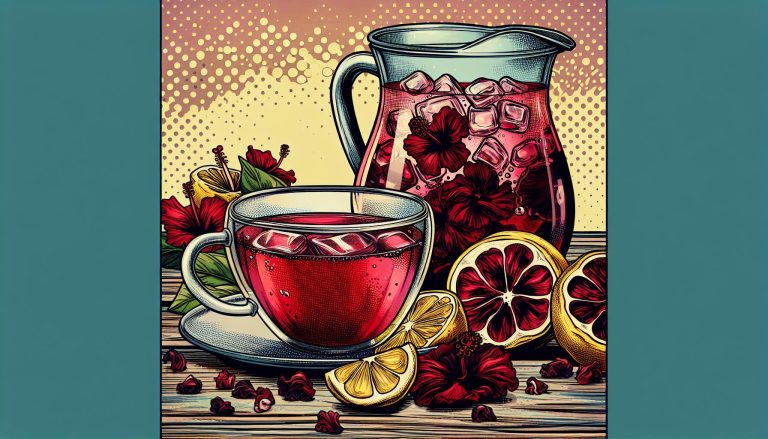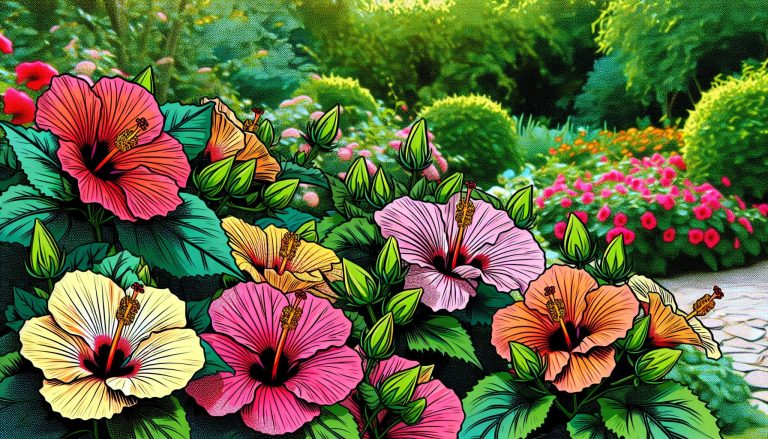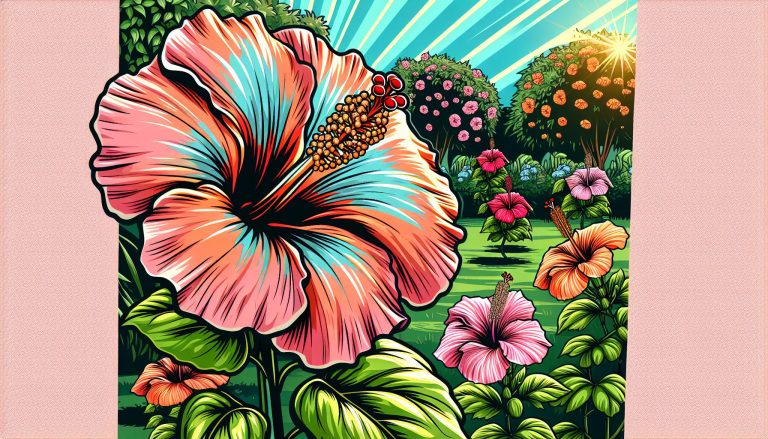Is Hibiscus a Perennial? Discover the Truth About These Stunning Garden Favorites
As a gardening enthusiast, I’ve always been captivated by the vibrant beauty of hibiscus flowers. Their large, showy blooms can instantly transform any garden into a tropical paradise. But one question that often comes up is: “Is hibiscus a perennial?”
The answer isn’t as straightforward as you might think. While some hibiscus varieties are indeed perennial, others are treated as annuals depending on the climate and growing conditions. In this article, I’ll delve into the world of hibiscus plants, exploring their diverse types and growth habits. We’ll uncover the factors that determine whether your hibiscus will return year after year or if you’ll need to replant each season.
Understanding Hibiscus Plants
Hibiscus plants are diverse and captivating, with numerous species and cultivars available. I’ll explore the different types of hibiscus and their unique growth habits to help gardeners make informed decisions about incorporating these beautiful flowers into their landscapes.
Different Types of Hibiscus
Hibiscus plants come in three main categories: tropical, hardy, and rose of Sharon. Tropical hibiscus (Hibiscus rosa-sinensis) boasts large, showy flowers in vibrant colors like red, pink, and yellow. Hardy hibiscus (Hibiscus moscheutos) features dinner plate-sized blooms and thrives in colder climates. Rose of Sharon (Hibiscus syriacus) is a shrub-like hibiscus with smaller flowers that bloom later in the season.
Hibiscus Growth Habits
Hibiscus growth habits vary depending on the species and environmental conditions. Tropical hibiscus grows as an evergreen shrub in warm climates but may die back in colder regions. Hardy hibiscus dies back to the ground in winter and re-emerges in spring, behaving like a herbaceous perennial. Rose of Sharon is a deciduous shrub that loses its leaves in winter but maintains its woody structure. Understanding these growth habits is crucial for proper care and maintenance of hibiscus plants in different garden settings.
Is Hibiscus a Perennial?
Hibiscus plants exhibit diverse growth habits, with some species being perennial and others annual. The perennial nature of hibiscus depends on the specific variety and the climate in which it’s grown. Let’s explore the perennial and annual hibiscus species to better understand their lifecycle characteristics.
Perennial Hibiscus Species
Perennial hibiscus varieties return year after year, providing long-lasting beauty to gardens. Hardy hibiscus (Hibiscus moscheutos) and rose of Sharon (Hibiscus syriacus) are prime examples of perennial hibiscus species. These plants thrive in USDA hardiness zones 4-9, surviving winter temperatures as low as -30°F (-34°C). Perennial hibiscus species typically die back to the ground in winter and regrow from their roots in spring. Some tropical hibiscus varieties (Hibiscus rosa-sinensis) can also be perennial in warm climates (zones 9-11) but require special care or overwintering indoors in colder regions.
Annual Hibiscus Varieties
Annual hibiscus plants complete their lifecycle within one growing season. While most hibiscus species are perennial, some are grown as annuals in colder climates. Tropical hibiscus, for instance, is often treated as an annual in regions with harsh winters. These plants don’t survive freezing temperatures and must be replanted each year or brought indoors during winter. Some gardeners in cooler areas choose to grow hibiscus as container plants, treating them as annuals outdoors during summer and moving them indoors for winter protection. This approach allows for the enjoyment of tropical hibiscus varieties in non-tropical climates without the commitment of perennial care.
Factors Affecting Hibiscus Longevity
Several key factors influence the longevity of hibiscus plants in gardens. Understanding these elements is crucial for successful hibiscus cultivation and ensuring their perennial nature in suitable environments.
Climate and Hardiness Zones
Climate and hardiness zones play a pivotal role in determining hibiscus longevity. Hardy hibiscus varieties thrive in USDA zones 4-9, withstanding winter temperatures as low as -30°F (-34°C). Tropical hibiscus, however, only survives year-round in zones 10-12, where temperatures rarely drop below 50°F (10°C). In colder regions, I’ve observed gardeners treating tropical hibiscus as annuals or moving them indoors during winter. Rose of Sharon exhibits impressive cold tolerance, flourishing in zones 5-9 and enduring temperatures down to -20°F (-29°C).
Proper Care and Maintenance
Proper care and maintenance significantly impact hibiscus longevity. These plants require full sun exposure, typically 6-8 hours daily, for optimal growth and blooming. Well-draining soil with a pH between 6.5-6.8 promotes healthy root development. I water my hibiscus deeply once or twice a week, adjusting frequency based on rainfall and soil moisture. Regular fertilization with a balanced, slow-release fertilizer (10-10-10) in spring and summer supports vigorous growth. Pruning is essential: I trim hardy hibiscus to ground level in late winter, while tropical varieties benefit from light pruning in early spring to maintain shape and encourage new growth.
Growing Hibiscus as a Perennial
I’ve learned that growing hibiscus as a perennial requires specific care techniques to ensure its survival and thriving across seasons. Here’s how I approach overwintering and maintain these beautiful plants through pruning and fertilizing.
Overwintering Techniques
For perennial hibiscus varieties, I use several overwintering techniques to protect them from harsh winter conditions. In zones 5-9, I apply a thick layer of mulch around the base of the plant, about 4-6 inches deep, to insulate the roots. For container-grown tropical hibiscus, I move them indoors before the first frost, placing them in a bright, cool spot with temperatures between 50-60°F. I reduce watering and stop fertilizing during this dormant period. In colder regions, I wrap the entire plant in burlap or use a specially designed plant cover to shield it from freezing winds and snow.
Pruning and Fertilizing Tips
Pruning and fertilizing are crucial for maintaining healthy perennial hibiscus plants. I prune hardy hibiscus in late winter or early spring before new growth emerges, cutting back the stems to about 6-8 inches above the ground. For tropical hibiscus, I prune in early spring, removing dead or weak branches and shaping the plant. I use a balanced, slow-release fertilizer (10-10-10) in spring when new growth begins, applying it monthly throughout the growing season. For container plants, I switch to a high-phosphorus fertilizer (5-10-5) in late summer to encourage more blooms. I always follow the package instructions to avoid over-fertilizing, which can lead to excessive foliage growth at the expense of flowers.
Benefits of Perennial Hibiscus in Gardens
Perennial hibiscus offers numerous advantages to gardeners seeking long-lasting beauty and ecological benefits. I’ve found that incorporating these stunning plants into my garden design has transformed my outdoor space and provided consistent rewards year after year.
Long-Term Beauty and Savings
Perennial hibiscus plants deliver enduring aesthetic appeal and cost-effectiveness. By returning each year, these plants save me time and money on annual replacements. I’ve noticed that my hardy hibiscus and rose of Sharon varieties establish stronger root systems over time, resulting in more robust growth and prolific blooming seasons. This long-term investment in my garden’s beauty allows me to enjoy spectacular floral displays without the need for yearly replanting.
Wildlife and Pollinator Attraction
My perennial hibiscus serves as a vibrant hub for local wildlife and pollinators. The large, showy flowers act as beacons for hummingbirds, butterflies, and bees. I’ve observed an increase in beneficial insect activity since introducing these plants to my garden. The nectar-rich blooms provide a valuable food source for pollinators throughout the growing season, contributing to the overall health of my local ecosystem. Additionally, the dense foliage offers shelter and nesting sites for various bird species, enhancing the biodiversity of my garden space.
Conclusion
Hibiscus plants offer a diverse array of options for gardeners with their stunning blooms and versatile growing habits. Whether perennial or annual their beauty can transform any garden. By understanding the specific needs of each variety and providing proper care I’ve found that hibiscus can thrive in various climates. With the right knowledge and techniques these show-stopping flowers can become a long-lasting centerpiece in your outdoor space. Remember that success with hibiscus comes from choosing the right variety for your region and giving it the attention it deserves.







